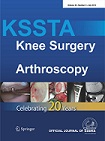
ARTHROPLASTY
No radiological or clinical benefit of patient-specific vs standard instrumentation in TKA
This report has been verified
by one or more authors of the
original publication.
Knee Surg Sports Traumatol Arthrosc. 2015 Dec;23(12):3637-45
81 patients scheduled for total knee arthroplasty were randomized to have the procedure completed using patient-specific instrumentation (PSI), computer navigation, or conventional instrumentation. The purpose of this study was to evaluate how groups compared regarding malalignment of the lower limb overall in the coronal plane, the femoral and tibial components in the coronal and sagittal planes, operative time, clinical outcome scores, and complications. The only significant differences that were observed were a significantly lower incidence of excessive malalignment (+/- 3-degree deviation) of the femoral component in the sagittal plane in the NAV group compared to the two others, and significantly longer operative time in the NAV group compared to the two others.
Unlock the full ACE Report
You have access to {0} free articles per month.Click below to unlock and view this {1}
Unlock NowCritical appraisals of the latest, high-impact randomized controlled trials and systematic reviews in orthopaedics
Access to OrthoEvidence podcast content, including collaborations with the Journal of Bone and Joint Surgery, interviews with internationally recognized surgeons, and roundtable discussions on orthopaedic news and topics
Subscription to The Pulse, a twice-weekly evidence-based newsletter designed to help you make better clinical decisions
Exclusive access to original content articles, including in-house systematic reviews, and articles on health research methods and hot orthopaedic topics
Or upgrade today and gain access to all OrthoEvidence content for just $1.99 per week.
Already have an account? Log in


Subscribe to "The Pulse"
Evidence-Based Orthopaedics direct to your inbox.
{0} of {1} free articles
Become an OrthoEvidence Premium Member. Expand your perspective with high-quality evidence.
Upgrade Now













































































